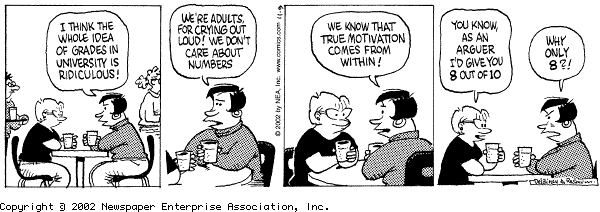|
Last Update: 7 March 2006
Note: |
|
Last Update: 7 March 2006
Note: |

Here are my theories about grading. Please feel free to send me comments or to discuss this on the newsgroup. I owe the basic idea here to my former teacher, Paul Vincent Spade, but he is in no way responsible for my elaboration of it.
0 = assignment not done
1 = assignment done, but clearly incorrect
2 = assignment done, but only partially correct
3 = assignment done, and clearly correct
Presumably, 0s, 1s, and 3s are clearly identifiable; anything not clearly identifiable is a 2.
For multiple-part items, each part can be graded on this scale, so, e.g., a programming project that requires a problem definition, a top-down design, documented code, and annotated output might be graded as follows:
| problem definition | 0 1 2 3 |
| top-down design | 0 1 2 3 |
| documented code: | |
| code: | 0 1 2 3 |
| documentation: | 0 1 2 3 |
| annotated output: | |
| output: | 0 1 2 3 |
| annotations: | 0 1 2 3 |
| Total possible points | 18 |
Or, e.g., a HW assignment with 10 problems could have each problem graded on the 0 1 2 3 scale, for a total of 30 points.
Or, e.g., a HW assignment one of whose problems has 2 parts: Each part could be graded on the 0 1 2 3 scale.
If the instructor wants to weight some part more than another, multiply by some factor; e.g., in the programming project example above, if the instructor feels that documented code is far more important than anything else, the instructor might use this:
| problem definition | 0 1 2 3 |
| top-down design | 0 1 2 3 |
| documented code: | |
| code: | 0 5 10 15 |
| documentation: | 0 5 10 15 |
| annotated output: | |
| output: | 0 1 2 3 |
| annotations: | 0 1 2 3 |
| Total possible points | 42 |
And so on. The main principle is to grade in quantum units.
The main advantage, besides ease of grading, is that the instructor doesn't have to argue with students over an extra point for a missed semicolon. (In general, a handwritten program whose only fault is a missed semicolon probably deserves full credit, unless the instructor is a real stickler for detail.)
It also tells the student more than some arbitrary number of points does: A 3 says ``you got it right (for all practical purposes)'', a 2 says ``almost, but not quite'', a 1 says ``nope'', a 0 says ``you didn't even try''; various weightings indicate relative importance.
Other variations: The instructor can always add a ``fudge factor'' to express an overall impression of a student's work. And so on.
0 = assignment not done
1 = assignment done, but clearly incorrect
2 = assignment done, but only partially correct
3 = assignment done, and clearly correct
I take:
0 = F
1 = D
2 = C
3 = A
since C is supposed to be ``average''.

What about B, you ask? Well, if enough assignments during a semester are given using this letter-grade scheme, Bs will appear when things get averaged. They will also appear, as will + and - grades, if the total number of points for a given assignment is large enough, using the following mapping:
| 3 pts | correct | A |
| 2 pts | partial credit | C (average) |
| 1 pt | incorrect | D |
| 0 pts | work not done | F |

For example, to take the 42-point programming project above, I would use
the following letter-grade equivalents (T = 42):
Undergraduate Grading Scheme:
factor grade range T = 100% width 3n A (17T/18 + 1) - T 95 - 100 T/18 17n/6 A- (8T/9 + 1) - 17T/18 90 - 94 T/18 8n/3 B+ (5T/6 + 1) - 8T/9 84 - 89 T/18 5n/2 B (7T/9 + 1) - 5T/6 79 - 83 T/18 7n/3 B- (13T/18 + 1) - 7T/9 73 - 78 T/18 13n/6 C+ (2T/3 + 1) - 13T/18 68 - 72 T/18 2n C (5T/9 + 1) - 2T/3 57 - 67 T/9 5n/3 C- (4T/9 + 1) - 5T/9 45 - 56 T/9 4n/3 D+ (T/3 + 1) - 4T/9 34 - 44 T/9 n D (T/6 + 1) - T/3 18 - 33 T/6 0 F 0 - T/6 0 - 17 (T/6 + 1)
A 41 - 42 A- 38 - 40 B+ 36 - 37 B 34 - 35 B- 31 - 33 C+ 29 - 30 C 24 - 28 C- 20 - 23 D+ 15 - 19 D 8 - 14 F 0 - 7 Graduate Grading Scheme:
Where n = T/3:
factor grade range T=100% width 3n A (17T/18 + 1) - T 95 - 100 T/18 17n/6 A- (8T/9 + 1) - 17T/18 90 - 94 T/18 8n/3 B+ (5T/6 + 1) - 8T/9 84 - 89 T/18 5n/2 B (7T/9 + 1) - 5T/6 79 - 83 T/18 7n/3 B- (13T/18 + 1) - 7T/9 73 - 78 T/18 13n/6 C+ (2T/3 + 1) - 13T/18 68 - 72 T/18 2n C (T/3 + 1) - 2T/3 34 - 67 T/3 n D (T/6 + 1) - T/3 18 - 33 T/6 0 F 0 - T/6 0 - 17 (T/6 + 1)

